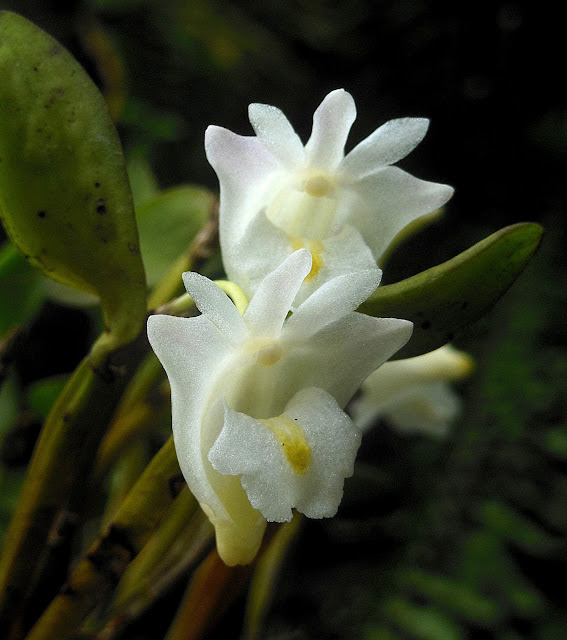A dendrobe with 'hymen flowers'
Last month a friend gave me a division of this orchid, a Dendrobium hymenanthum*, which I potted in a free-draining mix consisting of pumice stones and some leaf litter, and placed in a bright position with overhead netting. A month later, I noticed buds forming on several of the growths, which developed so rapidly that in just a few days, opened up.
The flowers are sharply fragrant, which makes sense because these blooms last for only a day and therefore had to make the most of its time by increasing the likelihood of the plant attracting potential pollinators.
Here's the entire plant. Those blooms may be short-lived, but these plants as well as related species flower several times throughout the year. This is a small-growing epiphyte, and the narrow and furrowed pseudobulbs are terminated by a pair of thick, oblong-ovate leaves. The blooms appear at the junction of these leaves.
However, not all the buds decided to join in the fun:
Dendrobium hymenanthum is widely spread in the lowlands of Indochina, Peninsular Malaysia, and the Philippines but is not well-represented in collections.
*In 2010 I moved Dendrobium hymenanthum to the genus Ceraia (OrchideenJ. 17:12) which was established by Joao Loureiro in 1790. Ceraia encompass those species placed under Dendrobium sections Rhopalanthe and Crumenata, and bear short-lived, often fragrant flowers that often are developed after a sudden drop in temperature, usually after rains following periods of prolonged heat and dryness. The flowers of Ceraia are all thin and membranous (including this species, whose species name 'hymenanthum' translates to 'membranous flower'), with the bases of the lateral sepals quite extended to form a well-developed mentum. Alas, ultra-conservative taxonomists opted to maintain an unwieldy genus in Dendrobium, whose only unifying feature appears to be in the pollinia number and the plants' sympodial growth. To make matters even worse, these plants are now maintained under Dendrobium section Aporum, or those species having non-pseudobulbous, flattened stems and laterally flattened leaves in two ranks. Granted, some ceraias have the same vegetative configuration, but hey, the flowers between Ceraia and Aporum are extremely different, with the latter having blooms that are smaller, fleshier, and structurally different, and labella with thickenings in the form of a prominent callus. The flowers of Aporum also are not ethereal as in the ceraias. The labellum ornamentations in Ceraia are in the form of ridges, sometimes broken up into papillae. Any beginning orchidologist, when presented with jars of preserved Aporum and Ceraia flowers, can easily separate the two apart, but the hallowed halls of Kew wanted things differently. At this point, I'll have the gall to say that we are in the dark ages of orchid taxonomy where clarity has been sacrificed for the sake of mere convenience.







TULLA is a free classified submission site in India, the USA, and global users in 2025. It helps individuals, entrepreneurs, and service providers post unlimited ads, promote businesses, and connect with genuine users. Whether you're buying, selling, renting, or offering services from electronics and jobs to dropshipping and dating TULLA offers a fast, simple, and reliable platform. With its user-friendly interface and wide range of categories, it empowers users to grow their reach, explore new opportunities, and thrive online without spending a rupee. Discover, connect, and succeed with TULLA your go-to destination for deals, visibility, and digital expansion.
ReplyDelete